STL Use cases
This document shows some of the usecases we can use STL definition for. It is a part of the STL Framework Documentation.
Automated layout conversion
In a traditional setting we use a static StoryTeller design and all dynamism must be realized during formatting. Such approach works great for relatively static cases, when overall layout is known in design-time and only content changes based on input data.
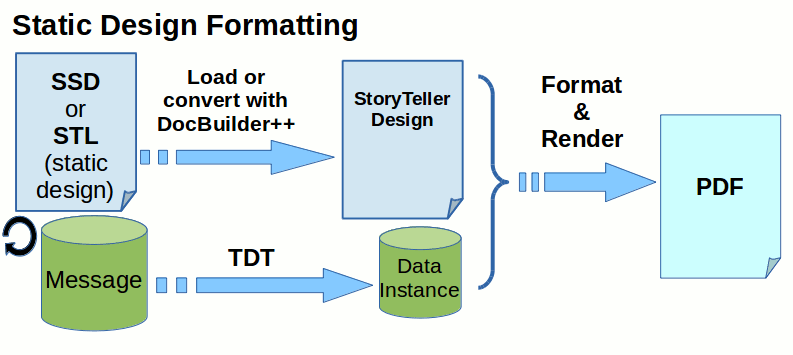
But here are also cases when input data contain style and even layout information, not just content. In such scenarios we need to integreate StoryTeller formatter with a different layout environment producing proprietary data formats or even designs.
For such cases it is possible to create a custom transformation generating StoryTeller designs dynamically based on given input data.

Naturally the two approaches above can be arbitrarily combined, so it is possible to realize some operations in conversion time, some in preprocessing time and others in runtime. There are different trade-offs for each approach so user should make consideration and look for an optimal solution for every problem at hand.
The following table lists individual
| Operation | Conversion-time | Preprocessor | TDT runtime | Formatter runtime |
|---|---|---|---|---|
| Variables | xsl:variable |
- | $variable |
require('vars') |
| Repeating | xsl:for-each |
- | tdt:value |
stl:repeater |
| Switch | xsl:choose, xsl:if |
- | tdt:value |
stl:switch |
| Substitution | xsl:value-of |
xp:include |
tdt:value |
stl:datasource |
| Reuse | xsl:call-template |
xp:include |
- | stl:fragment |
| … | … | … | … |
Consider the following (real world) example:
- Expected Output (PDF)
- Source Data (XML)
- Design Transformation (XSLT)
- Load-time Stylesheet (CSS)
- Generated Design (STL)
- Formatted Output (PDF)
Generated Fragments
In previous section we generate whole design dynamically. But it is also possible to use a static host design and use a dynamically generated STL fragment, so that we dynamically create or modify a page object or a story content.
In the following example we use a host design containing script used for dynamic content creation. The script dynamically loads CSV file containing customer data. For that purpose we are using the PapaParse javascript library. Let’s imagine that we want to schedule a 25 minutes long meeting for each our customer. With Markup.js javascript template engine it is fairly easy. We loop over each customer and create a table row containing customer data. We even use dynamically created class names to create zebra effect:
<stl:table class="table" w="100%">
<stl:story>
<stl:row h="50pt">
<stl:cell class="trow"><stl:p></stl:p></stl:cell>
<stl:cell class="trow">
<stl:p>, </stl:p>
</stl:cell>
...
</stl:row>
</stl:story>
</stl:table>
In right-most column there is a dynamically created analog clock face
for each customer meeting. We use an SVG fragment for background and
dynamically create/rotate clock hands with help of registered filter
functions Mark.pipes.minutes and Mark.pipes.hours.:
<stl:group transform="scale(0.1)">
<stl:fragment src="wd:/clock.svg" selector="/item[1]" />
<stl:group transform="translate(1024 1024) scale(0.22)">
<stl:path class="handh" data="M -50,-600 l 50,-50 50,50 0,800 -100,0 z" transform="rotate()"/>
<stl:path class="handm" data="M -40,-900 l 40,-40 40,40 0,1180 -80,0 z" transform="rotate()"/>
</stl:group>
</stl:group>
Dynamically created STL definition file is then uploaded to blob repository and resulting URI is set to the content substitution. System automatically detects the STL syntax and uses DocBuilder to create StoryTeller content fragment.
- Host Design (STL)
- Dynamic Addresses (CSV)
- Content template (STL + Markup.js)
- Clock fragment (SVG)
- Formatted Output (PDF)
While we understand STL format as an alternative format for maintaining StoryTeller documents at the same time we plan to utilize STL in scenarios where StoryTeller does not figure at all.
TDT-based document creation
Consider a case when we have an HTML or SVG template and we want to use TDT transformation for making some dynamic modifications based on input data. Then we can utilize STL as a serialization format associating HTML template with set of TDT rules and possibly other assets like other streams containing client-side logic (javascript) and styling information (CSS stylesheet).
Following two examples demonstrate such approach:
HTML Invoice
In this example we create more sophisticated HTML invoice which could in principle serve directly as a StoryTeller Document Output. Please, note that StoryTeller Formatter Engine is not invoked at all in this case - the resulting HTML is a direct result of the TDT Transformation Engine.
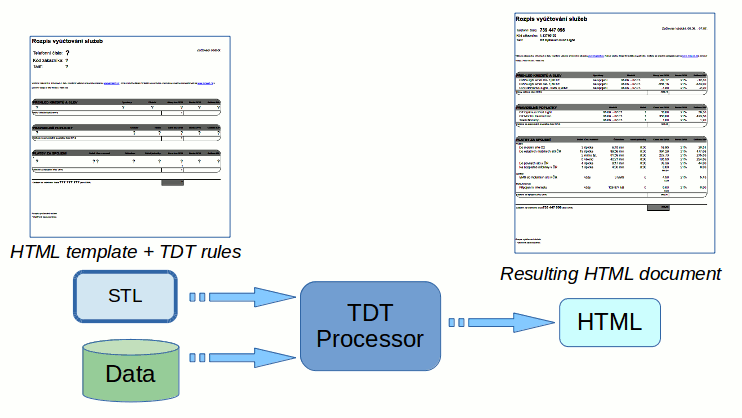
The HTML Template is kept separately from associated TDT Transformation Definition and so can be easily edited and maintained with a specialized HTML Editor (as far as references from associated TDT remain valid).
SVG Chart
This example demonstrates a possibility to create SVG graphics via STL definition format. No Formatter or an Image Library is used for the SVG creation, just the DocBuilder++ and TDT Data Transformation.
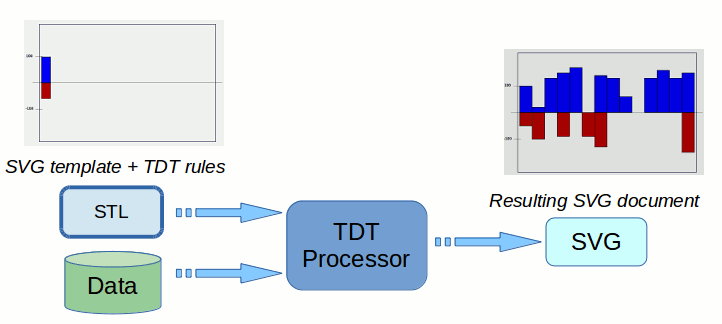
The SVG Template is kept separately from associated TDT Transformation Definition and so can be easily edited and maintained with a specialized SVG Editor (as far as references from associated TDT remain valid).
Dynamic HTML
Another approach would be to generate a responsive and dynamic HTML directly from STL.
Currently we support two kinds of HTML outputs:
- Paginated HTML … produced by StoryTeller formatter followed by a surface-based paginated HTML driver (this output uses HTML format only to emulate other paginated formats like PDF).
- Static HTML … produced by StoryTeller formatter followed by an enumeration HTML driver (this output is designed to imitate PDF-like static content as closely as possible without breaking it to individual pages)
But consider another approach - yet another flavour of HTML driver - producing truly Dynamic and responsive HTML.
For such cases the StoryTeller Document Model and Formatter represent very limiting factor. Converting our internal document representation to HTML looses lots of information. Much easier approach would be to bypass the StoryTeller engine completely and convert STL description directly to HTML as can be seen at the bottom of the following diagram:
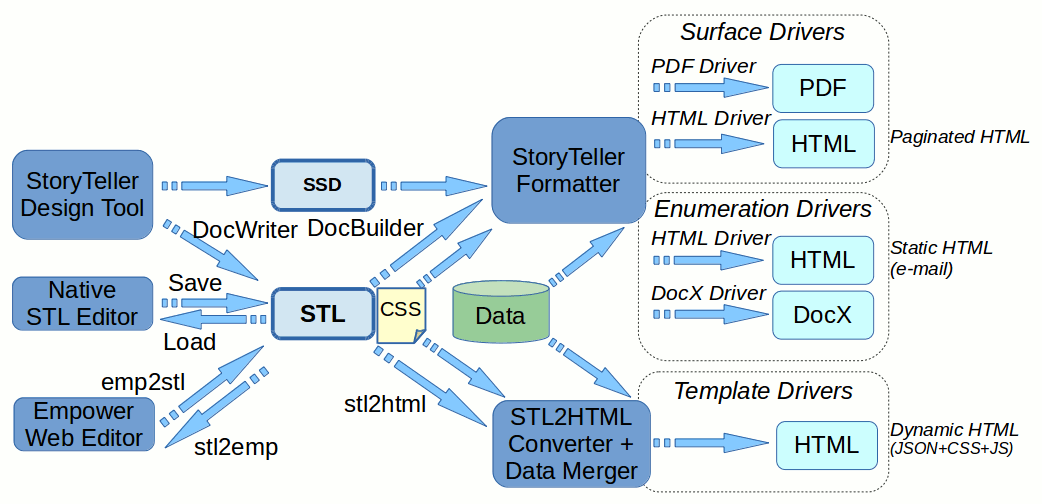
Consider the following example demonstrating the dual approach:
- Design (STL)
- StoryTeller generated PDF
- StoryTeller generated HTML
- StoryTeller generated Layout HTML
- Design Transformation (XSLT)
- Directly generated HTML
More Detailed diagrams demonstrate both approaches (quite similar to an old diagram of Dynamic HTML):
Conversion to PDF:
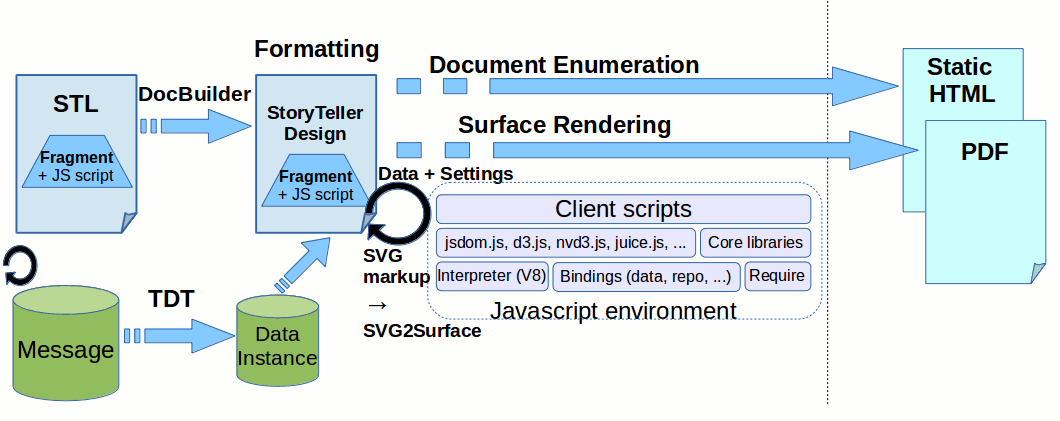
Conversion to responsive and dynamic HTML:
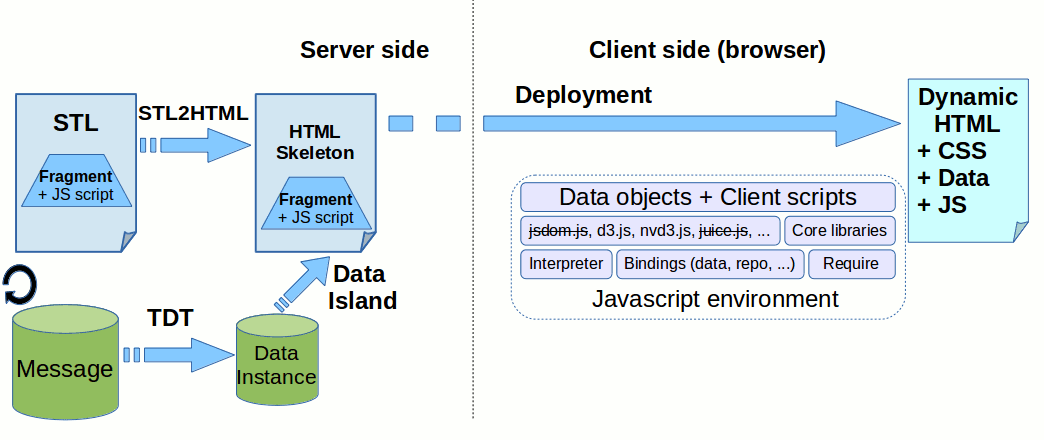
The example above demonstrates that in principle any runtime operation (repeaters, switches, substitutions, runtime scripts) can be executed not just in context of StoryTeller formatter, but alternatively in context of HTML document object model. Moreover the scripts can be executed not just on server-side, but alternatively on client-side (in web browser).
But we can go even further - we can implement /stl2html/ conversion in client-side javascript completely. That way we get much more responsive experience for interactive tools like online editors, document preview etc.
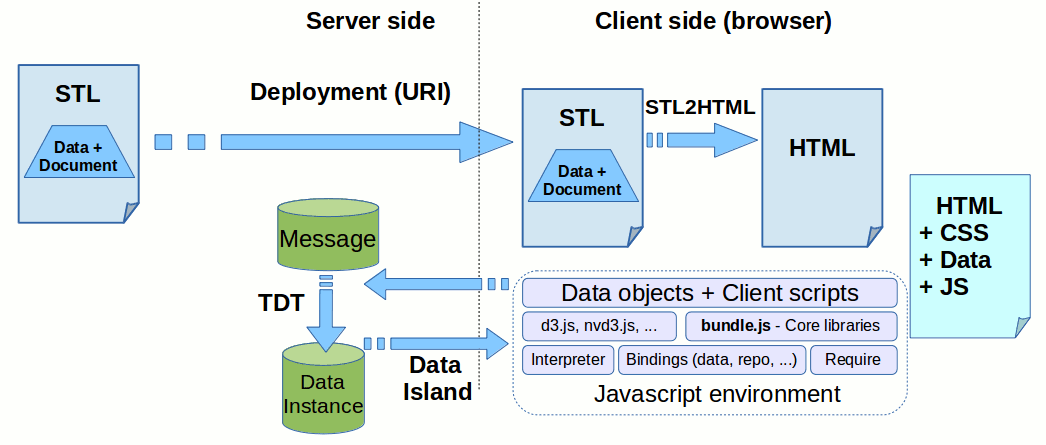
Only services which are currently not available for client-side can be called back to an underlying server. And in case there are no such services needed, we can run in browser completely. Like in case of this example of an Interactive STL editor.
The following table summarizes how individual components cooperate in various scenarios.
| Engine / Phase | Server-side | Mixed | Client-side |
|---|---|---|---|
| StoryTeller | ST batch production | ST preview (REST) | On-demand PDF (REST) |
| TDT | ST Data Instance | ST Data Island | On-demand Conversion (REST) |
| STL2HTML | X | Create HTML Skeleton | Create HTML Document |
| Browser DOM | Static HTML (email) / | Dynamic/Responsive HTML | Realtime Preview |
| PDF attachment |